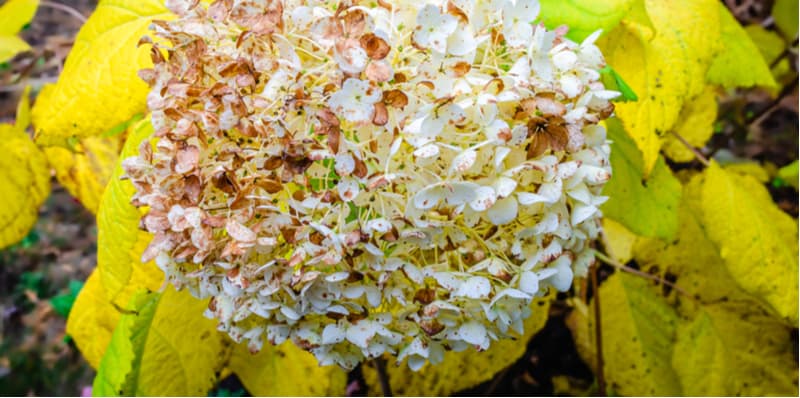Hydrangea Leaves Turning Yellow Fundamentals Explained
Wiki Article
The Greatest Guide To Hydrangea Leaves Turning Yellow
Table of ContentsSome Known Details About Hydrangea Leaves Turning Yellow Getting The Hydrangea Leaves Turning Yellow To WorkWhat Does Hydrangea Leaves Turning Yellow Do?Getting My Hydrangea Leaves Turning Yellow To Work
Hydrangea plants are known for their lovely blossoms, yet in some cases their fallen leaves can turn yellow. This is generally an indicator that something is wrong and the plant requires your aid.Hydrangea leaves transforming yellow can be a cause for worry. Hydrangea leaves usually turn yellow when the plant is overwatered.
When the origins of a plant are immersed in water for extended periods, they begin to asphyxiate and rot. This procedure cuts off the origins' oxygen supply, triggering the fallen leaves to transform yellow and eventually pass away. Overwatering can also bring about various other issues such as fallen leave drop, root damage, and fungal growth.
If you assume your Hydrangea is overwatered, the best solution is to allow the soil dry completely prior to sprinkling once again. It's likewise a good idea to inspect the drainage of your pot or yard bed and ensure that water is not merging around the plant's roots. Hydrangea plants require well-drained dirt to grow.
The Ultimate Guide To Hydrangea Leaves Turning Yellow
You need to also make certain that you are not sprinkling your Hydrangea frequently. Watering as soon as a week should be sufficient, and regularly if the weather condition is warm and dry. Hydrangea leaves can also turn yellow if the plant is not getting sufficient water. This takes place when the plant does not obtain adequate water, and the dirt starts to dry out.
This is recognized as "fertilizer melt," It takes place when the plant's roots are subjected to also much fertilizer. Other indications of plant food melt include brownish or yellow fallen leaves, wilting, and stunted growth.
This will certainly help eliminate any excess fertilizer from the roots of the plant. It's also a great idea to minimize the quantity of fertilizer you are making use of. Feeding as soon as a month throughout the growing season must suffice. Homepage If you are making use of chemical plant food, it's best to make use of one that is watered down and applied according to the producer's instructions.
About Hydrangea Leaves Turning Yellow

If your Hydrangea is ravaged with insects, their explanation treating the look at this site plant with neem or gardening oil is the ideal service. It's additionally excellent to eliminate any kind of affected fallen leaves from the plant (Hydrangea Leaves Turning Yellow).
To stay clear of spreading the disease, make sure to disinfect your scissors before cutting any kind of leaves off. Hydrangea leaves can likewise turn yellow if the temperature level emphasizes the plant. This usually occurs when the plant is subjected to severe cool or warm. The fallen leaves of the plant will turn yellow and start to drop off.
If the temperature level worries your Hydrangea, you require to move the plant to a place where it will certainly be safeguarded from the extreme cold or heat. You can additionally attempt to provide the plant with some partial shade if revealed to guide sunlight. You can likewise try adding mulch around the plant base to help manage the temperature level.
How Hydrangea Leaves Turning Yellow can Save You Time, Stress, and Money.
When the plant's origins are submerged in water for too long, they start to rot. One of the most common root rot signs is yellowing leaves, as the fungi avoids the roots from absorbing nutrients from the soil.Other signs of root rot include stunted development, wilting, and fallen leave decline. Check the roots of your Hydrangea if it has origin rot. If they are black or brownish, then they are most likely rotten. If some healthy origins are left, you can attempt to conserve the plant by replanting it in a new pot with fresh soil.
Water the plant meticulously, seeing to it not to overwater it. If your Hydrangea is heavily affected by origin rot, beginning with a brand-new plant is best. All-natural causes can likewise trigger yellow hydrangea leaves. The most common reason is the plant's age. As Hydrangeas age, their leaves will slowly turn yellow and brown before falling off the plant.
You can help the plant by ensuring it is obtaining enough water and nutrients. You can also mulch around the plant base to help it maintain dampness. There are several reasons hydrangea leaves could transform yellow and fall off. Hydrangea Leaves Turning Yellow. One possibility is that the plant is not obtaining sufficient water.
Report this wiki page